When you start working on the SEO side of a business, you first need to select the keyword you will target with your new SEO campaign.
This is the same for SaaS, ecommerce, content, and other online businesses.
In this article, we will take you through choosing the right keywords to target with your SEO campaigns. We’ll cover finding keyword ideas, clustering these ideas together, the critical SEO data points to collect for each keyword, and finally, how to take all this information and individually score each keyword opportunity to help you prioritize your work.
So, let’s jump right into it.
Step 1: Establishing Your Keyword Ideas
In this first section, we will take you through several different tactics you can use to establish your keyword list. This section will include information on speaking to customers and using paid tools to drill down further into competitors.
Speak to your Existing Customers
Before looking at the rest of this article and working on the SEO tips outlined below, you need to speak to your customers. Ask what problems your customers have that you can solve, and ask what they’d type into Google to search for what your business offers.
This step is often overlooked when coming up with keyword ideas.
The outcome should be a compilation of search queries derived from customer feedback, ensuring you understand what potential customers are inputting into search engines to solve their issues and, crucially, discover businesses like yours.
Once you have a list of topics and keyword ideas from speaking to customers and the support or sales team, you can use the best free keyword research tool available…Google ?
Look at People Also Ask Boxes
Let’s say, for example, that you run a furniture company and are speaking to customers, and you find out that many of your customers come to you after first searching for DIY options.
An example search term might be “how to build a desk”. If this is the case, search this query on Google and look at the questions that are coming up in Google’s ‘People Also Ask’ boxes, as this will give you more great ideas on content that you can publish shortly:
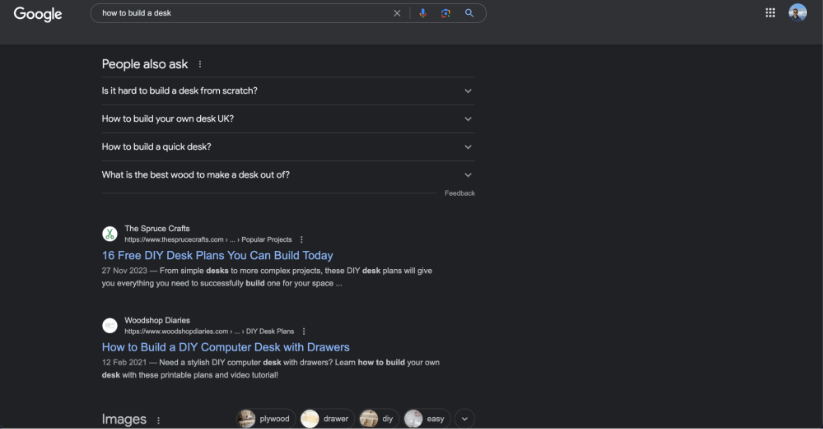
As we can see from the above, we get some excellent question examples:
- Is it hard to build a desk from scratch?
- How to build a quick desk?
- What is the best wood to make a desk out of?
These are all candidates for blog posts that you can publish. From there, you are bound to get more customers who arrive at your door after trying the DIY route and realizing it is not for them.
Look at Google Autocomplete Terms
Google Autocomplete is a goldmine of untapped search potential. Google will spit out popular and trending keywords from a single word based on the word you type first.
Using the same example of running a furniture company, let’s enter ‘desk’ into Google and see what Autocomplete suggests:
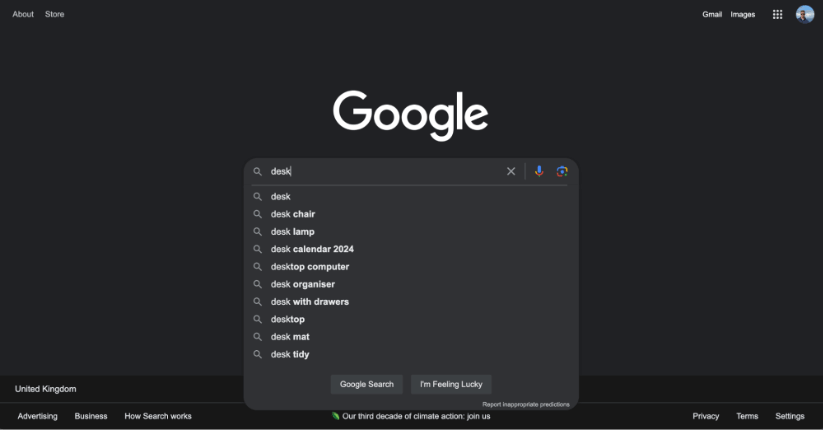
There are some great candidates here:
- Desk lamp
- Desk chair
- Desk organizer
- Desk with drawers
- Desk mat
- Desk tidy
These represent potential expansion opportunities for your business or related topics to write about. Logically, if a customer purchases a desk, there’s an opportunity to upsell some of these items during the transaction.
It also serves as an excellent example to split out your product pages. For example, some companies may target ‘desk’ and ‘desk with drawers’ with the same Product Listing Page (PLP). Still, given Google Autocomplete is showing this in its section, you may wish to go further and use two different PLPs to target them as different search queries.
Find the Top 20 Websites & Conduct Competitor Research
For each search query you gather when speaking to customers, it makes sense to search these queries individually and note the top 20 websites ranking for the terms. This gives you a head start on any competitor research you need.
Again, using our online furniture store example, if they were to search ‘oak sit/stand desk’ on Google to find what they need, they would find some good competitor ideas straight away:
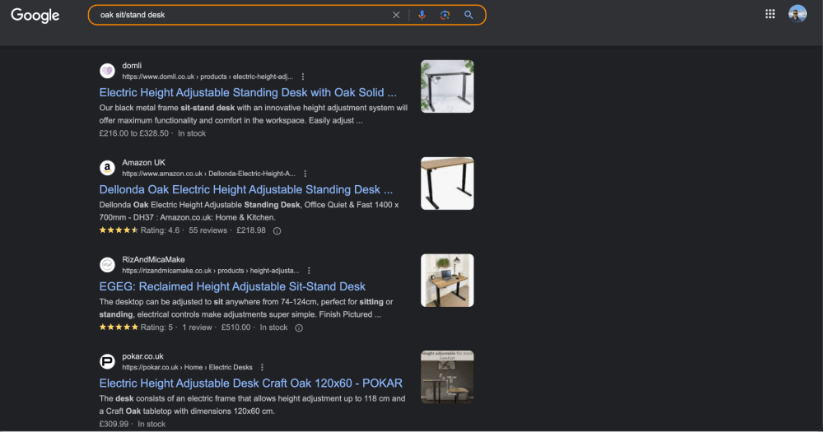
Some companies that have come up include Domli, Amazon, and Pokar. You can also see that they are targeting this particular keyword with an actual product page rather than a product listing page, giving you all the data you need to go ahead and create a product page for an oak sit/stand desk.
The best part?
You do not need access to any paid tools to do all of this. You can do this by simply using Google and inputting some sweat equity. Once all of the above is done, you’ll already have some great keyword ideas you can start targeting immediately before moving on to any work with tools requiring subscriptions.
Finding Keyword Ideas Using Paid Tools
This section will discuss how to find the keywords your competitors are targeting, expand your keyword list from a seed keyword, and find ‘quick win’ opportunities for your business.
Find Competitor Keywords
When starting a new SEO campaign, one of the first things I do is find the keywords my competitors are targeting.
You already have a list of competitor sites from your manual search of Google that we outlined above, but you can add to this list using paid tools such as Ahrefs, SEMRush, and SERanking.
The advantage of using paid tools is that they give you a great insight into the keywords that work for your competitors. And if they’re working for your competitors, then there is a good chance they will work for you, too, if you can overtake your competitors in the SERPs.
Let’s say, for example, that I want to find the keywords that IKEA are actively targeting when it comes to sit/stand desks. I’ll simply log into Ahrefs and enter their sit/stand desk URL into the ‘Site Explorer’ tool:
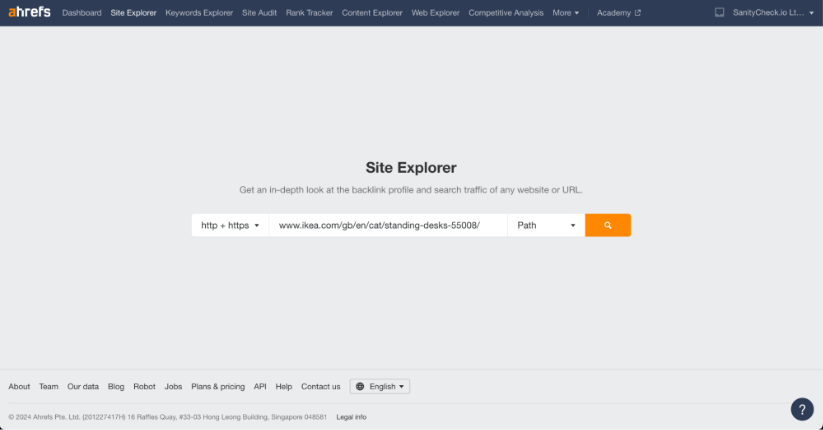
Note: We just need to ensure that the filter (as shown above) is selected as ‘Path’. That way, Ahrefs will only bring through information for this URL and other relevant URLs, not URLs for the site as a whole.
From here, I can head into the ‘Organic Keywords’ section to see what organic keywords work for IKEA.
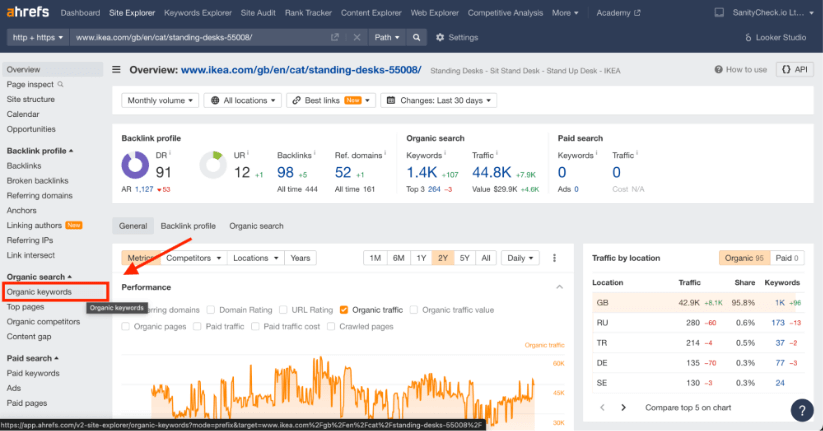
Once here, I can see what keywords work for them and select a few to target!

I can see good information like where IKEA currently ranks, what difficulty Ahrefs believes the keyword is listed, and what URL ranks IKEA for each keyword. This is all the information I can add to my strategy.
As we can see in the screenshot above, they are ranking at Position 1 for “adjustable desk” with their product listing page. If we sell similar products, we now know that we should create a similar PLP for this and target this keyword with that new page that has been created.
Expand from a Seed Keyword
You can also use Ahrefs to find other keyword opportunities using a single keyword. This is incredibly useful when you have a smaller keyword list and want to expand on it to find more ‘hidden’ opportunities.
Head to the ‘Keyword Explorer’ tool within Ahrefs and enter your seed keyword. For this example, we’ll use the seed keyword as ‘sit stand desk’ and see what Ahrefs spits out:
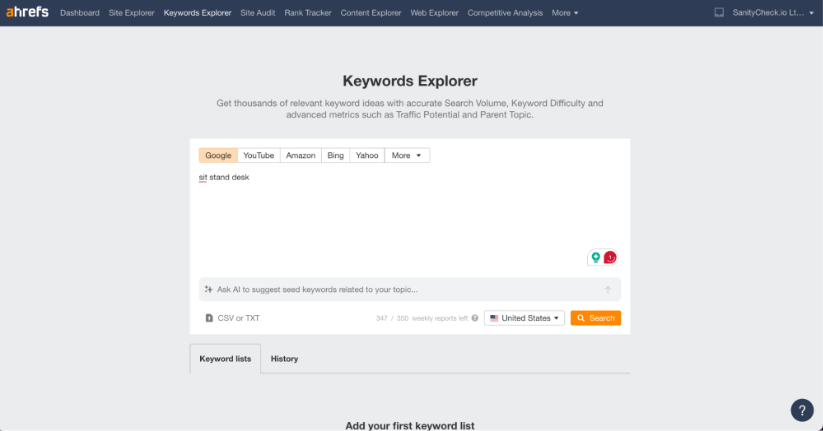
Once you do this, hit ‘Search’, and you will be given information on this keyword. But not only that. You’ll also be given a list of keyword ideas, including:
- Terms match keywords or longer keywords that include the seed keyword.
- Question-based keywords which are questions that contain the seed keyword.
You can see these when you scroll a little further down the page on Ahrefs:
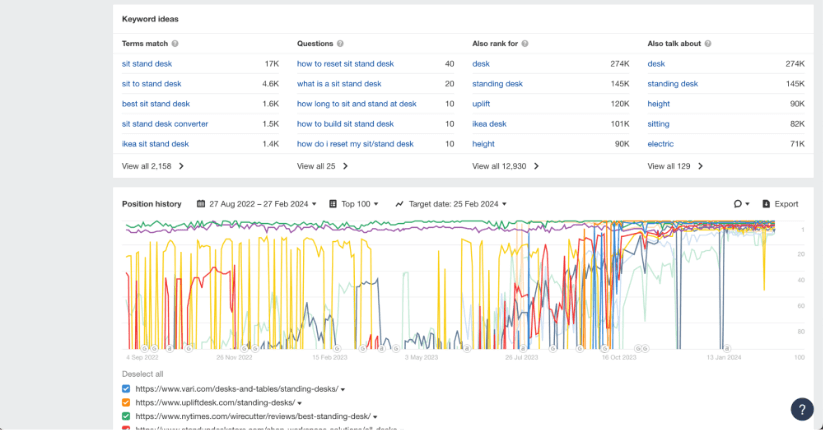
You’ll notice that 2,158 terms match keyword opportunities and 25 question-based keywords. We can jump into each of these separately, filter them down and add relevant opportunities to our keyword list.
Find ‘Quick Win’ Opportunities
To end this first section, it’s also vital that you scour your website as it currently stands to find any ‘quick win’ opportunities.
Quick wins are keywords ranking just outside the top 10 of Google’s search results. We call these Striking Distance Keywords. With some work, getting them into the top 1-6 places will likely lead to a nice bump in clicks.
Finding these keywords can be done in several ways; you can do a similar step to the one listed above and use Ahrefs to find your existing keywords, and then filter this keyword list to rankings that you currently have at Position 10 to Position 15. You can then export this and start working right away.
I use SEOTesting for this. Within SEOTesting, we have our Striking Distance Keywords report:

With one click, you can find all of the keywords where you are currently ranking just outside of Page 1. With just a little work with these queries, such as adding the keyword to the page or adding internal links, you can boost your rankings and get more clicks.
You can also access essential data like the number of clicks and impressions you currently get, all directly from Google Search Console.
We now have an extensive list of keyword ideas, but we must choose which keywords to tackle and take forward.

The Second Step: Selecting Target Keywords from your List
This next section will explore how to organize your new-found keywords by the opportunity. You do not want to be working on any keywords that will be a waste of resources for your business, especially at the start of an SEO campaign, so following these steps will help you find the keywords that will work best for your business.
Clustering
We need to consider any keywords in our ideas list that Google treats as the same keyword.
This is a crucial step because, in 2024, having a long list of keywords to target may result in wasted effort, time, and (most importantly) money for your business.
Let’s look at an example. Say we have discovered the following keyword ideas:
- Standing desk
- Adjustable desk
- Stand up desk
- Height adjustable desk
A common question in SEO communities is, “Do I need to create a separate page for each query, or will a single page cover them all?”
The answer to this is something called keyword clustering. You can do keyword clustering manually using Google and reviewing the search results or automatically with a tool.
Option 1: Manual keyword clustering
Manual keyword clustering involves searching for each keyword idea on Google.
If you take two different keywords and the search results are very similar, for example, the same eight pages appear in the search results, a single page can be created to target both keywords.
Can you do this manual process for hundreds of keyword ideas? No way!
But if you have a small list of between 2 – 10 keyword ideas – get Googling and use the SERPs.
Option 2: Utilize a Keyword Clustering tool
When you have hundreds (or thousands) of keyword ideas, using a tool to cluster the keywords together makes an impossible task achievable.
A tool such as Keyword Insights does the same manual SERP process as we explained above, but using computer processing power and a sprinkling of machine learning, it can do the SERP analysis and clustering of thousands upon thousands of keyword ideas.
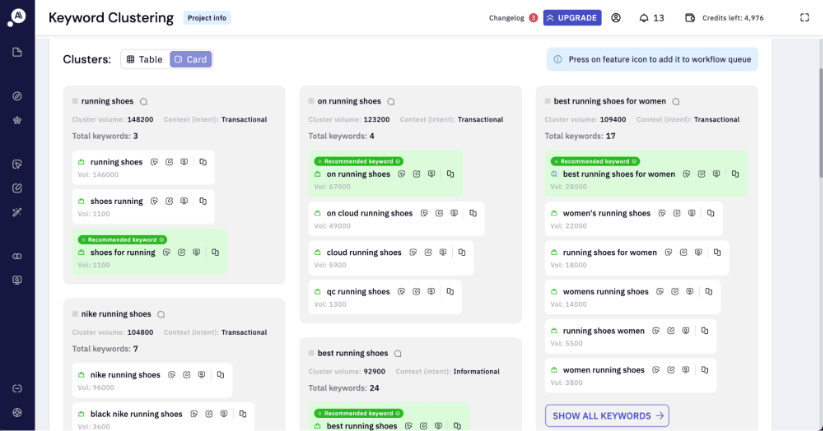
In the above screenshot, we can see the different clusters that Keyword Insights has found for 500 keywords, all related to ‘running shoes’. I imported 500 running shoe-based keywords from Ahrefs, and Keyword Insights has clustered them into relevant clusters.
When I create my content, I can create one piece for each cluster, focusing on the target keyword recommended by Keyword Insights. It’s a great way to save time, money, and overall investment when creating lots of content.
You’ll also notice that Keyword Insights also gives you the total search volume for each cluster, so you can order your clusters by opportunity size, much like you’d do with individual keywords. They also give you the search intent of each cluster. Using a tool like this makes this process super simple.
Relevance
The keywords with the most potential for your business are those with high relevancy.
Some keywords are just going to be irrelevant to your business. I like to call these ‘incidental keywords,’ these can be described as keywords that you rank for but are not going to find any business value in. This can come from wording you’ve written in blog posts, videos you’ve published, or even social media on some occasions. If you see any of these, you can quickly move on.
Let’s use the same example we have been using throughout this article:
You run a furniture manufacturing business and sell sit/stand desks online. You might find that your website starts ranking for keywords such as “desk stool”, which might not be relevant to your business if you do not manufacture desk stools and choose to focus on desks instead. Of course, you can always argue that if you created content to match this intent and put in some handy CTAs within your content, you could find some (keyword, some) business value there, but there are many other opportunities you should focus on first.
Pay Attention to Keyword Difficulty
Consider keyword difficulty if you want to add more detail to your process. Tools such as Ahrefs and Semrush have their keyword difficulty scores, which look at the stats of the current ranking sites to estimate how hard it will be to make it into the top rankings based on what is already ranking there.
If a keyword difficulty score is high, it doesn’t mean it’s impossible to rank there, but it does mean that you will need to work harder:
- Create better content.
- Build more relevant backlinks.
- Maybe get more social shares.
- Ensure your readers have the best experience.
To beat the more prominent websites that rank there already.
Important Note: A “high” keyword difficulty will differ depending on the area you are located in, the niche your business is in, the levels of competition, etc. You can establish low/medium/high keyword difficulties by analyzing your entire keyword list, looking at the current KD levels, and deciding for yourself.
If you find a keyword difficulty score up there, you should save these for later, once your site has more authority, before you target these keywords. Go for keywords with lower KD scores, especially at the start of campaigns.
Search Volume
When you settle down to organize your content into opportunity-fit, consider the search volume for the keywords you want to target. A keyword can be a great fit and relevant to your business, but if it only gets ten searches per month, it might be worth placing less importance on this keyword than others you wish to target.
The standard SEO toolkits, such as Ahrefs, Semrush, and Moz, make finding the estimated keyword search volume easy. But remember that these are estimated, and you should take them with a pinch of salt.
When analyzing keywords in these types of tools, they make it very easy to find the estimated search volume:
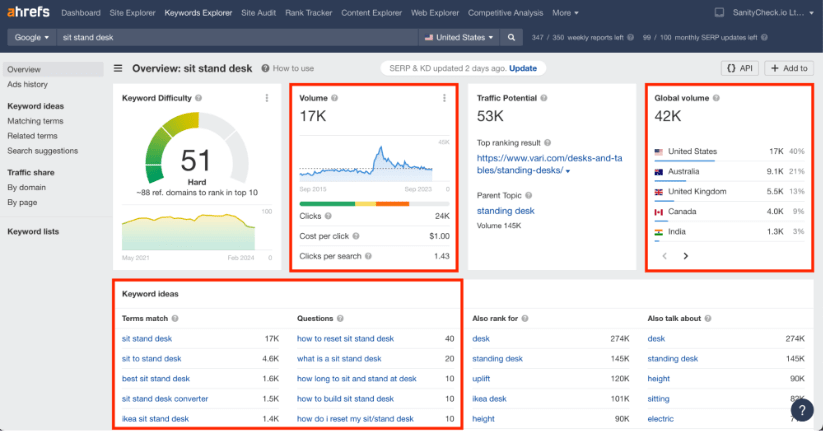
Using Ahrefs as an example, we can see the estimated MSV (monthly search volume) for the target keyword in the US, the global search volume, and the estimated search volume for related keywords.
This makes it incredibly simple to organize our keywords by the opportunity size.
Matching Keywords to Search Intent and Content-Type
So now you’re at the stage where you have found the keywords you want to target and sorted them by the size of their opportunity. Wonderful! But there is one more thing you need to consider before the ‘real’ work can begin.
You need to look at the search intent of each keyword.
Luckily, this doesn’t take too long. But it is a crucial step! In this section, we’ll discuss search intent and how to create content that matches search intent.
What is Search Intent?
Search intent refers to the reason or purpose behind a search query on a search engine. It’s what the user hopes to find/achieve when searching. Understanding search intent is crucial for content creators and search engines as it helps deliver users the most relevant and valuable results.
There are, generally, four main types of search intent:
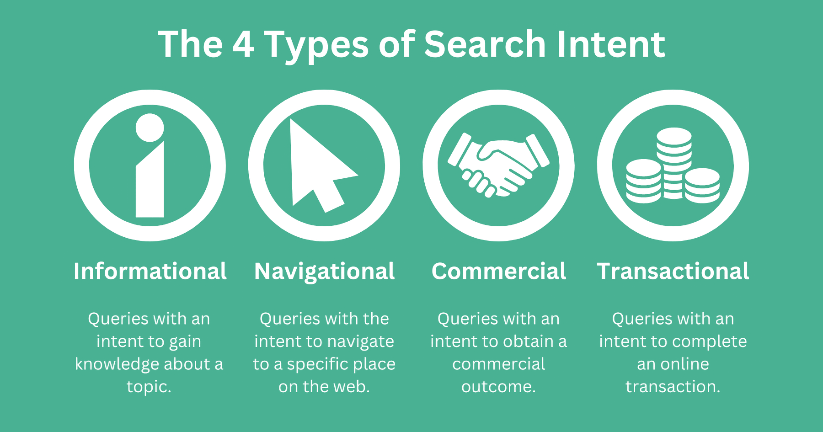
Creating Content to Match Search Intent
If you do not create content that matches the intent of your target keyword, you simply will not rank. This is the same for all websites, small and large, massive or without budget.
Luckily, establishing the type of content you need to create is easy. Type in the keyword into Google and look at the top-ranking results. Let’s say we want to target the keyword of ‘sit/stand desks” for example:

We can see from these results what type of page/content we need to create. To have the best chance of success, we’d need to create our product listing page showing all of the sit/stand desks we have available for sale.
You may also notice that, at the top of the screenshot above, there is an article detailing the ten best-standing desks that deserve an ovation. Why is this appearing along with product listing pages? As it turns out, this particular keyword has what’s referred to as a ‘mixed intent‘ behind the search. Essentially, Google has recognized that some people want to find articles on the best sit/stand desks when searching for this keyword, and others want to look at products. There are lots of keywords out there like this that have mixed intents and deserve special attention. In this case, it might be best to create two separate pages. One page targets the article, and the other targets the product listing page.
Option 1: Manual Analysis
To conduct a manual SERP analysis, enter your target keywords into Google and carefully examine the top ten results. A few months ago, we’d have focussed on ‘Page 1’ of the SERP, but since Google has introduced infinite scrolling, pages are less of a concern.
Note the types of content that appear at the top. Are they blog posts? Product pages? Or something else entirely? Look into each page and look for commonalities in the titles and the presence of media, such as images and videos, and note this down so you can include some in your content, too.
You also need to look at the SERP features. Are there People Also Ask boxes or featured snippets on the SERP? If so, you may also tailor your content to appeal to these.
The final step would be to evaluate the domain authority of the websites that rank, as this will give you a good idea of the level of competition you’re about to face for those top positions. Third-party tools create domain authority, domain rating, and other metrics, so use these as a guide rather than an absolute measure.
Option 2: Automated Analysis (Using Tools)
You can also conduct SERP analysis almost automatically with the help of tools like Semrush, Ahrefs, or Moz. These tools can streamline the process by providing detailed insights about the SERP, including:
- The estimated search volume for each keyword.
- The ranking history of different pages.
- A quick analysis of the backlinks each page has.
They can also highlight SERP features that your search competitors might leverage, like Featured Snippets or knowledge panels.
This automated analysis saves time, offers a more data-driven approach (which we SEO professionals love), and allows you to craft a more informed and strategic plan without the intensive manual work of analyzing SERPs manually.
Rating your Keywords by Business Impact/Potential
When creating a keyword map for your new SEO strategy, whether working on a brand new website or taking the reigns of an established website, prioritizing keywords based on their business impact or potential is crucial for optimizing your ROI.
This strategy enables you to focus your resources on targeting keywords that drive significant traffic but also attract visitors with a high intent to purchase or engage with your services.
By identifying and prioritizing these high-impact keywords, you can craft more effective and targeted content, improve your website’s rankings in search engines for relevant queries, and ultimately increase conversions and revenue.
Rating keywords by business impact ensures that your marketing efforts align closely with your business goals. This makes your SEO campaigns more efficient and effective.
Selecting your Target Keywords
We have collected all the separate data points relating to your keyword ideas. It’s time to combine it and use that data to prioritize your ideas.
We can put all the data points we have into a spreadsheet so we can use a formula to calculate which keyword ideas we should tackle first.
- Clustered keyword idea
- Business relevancy (score 1-10, 1 is irrelevant, 10 is highly relevant)
- Keyword difficulty (inverse score 1-10. 1 is challenging, 10 is low difficulty)
- Search Volume (score 1-10. 1 is low search volume, 10 is high search volume)
- Search Intent (helpful info)
- Business Impact (score 1-10. Will the page bring in new sales/conversions?)
- Content Type (score on how easily you can create the content type. 1-5)
The overall score for the target keyword will be:
Business relevancy * Inverse of Keyword Difficulty * Search Volume * Business Impact * Content-Type

Sticking with our standing desk example, we can see four clustered keyword ideas from our keyword research.
Using the data points we have, we can then calculate a score for each keyword and select the keywords we will target based on this.
Standup desk is an obvious keyword for us to target. This is the main product we sell.
Best desk stools – we do not sell these, and although the keyword difficulty is low, there is not much search volume. We can drop this idea further down our task list.
Anti-fatigue standing desk mats are significantly related to standing desks and offer an upsell opportunity. Keyword difficulty is on the easy side, and while the search volume is low, the overall score shows this is a good keyword to target.
Cycling desks – our site focuses on office workers, so the business relevancy is low. This could be a new niche for the business to branch into later. It may be worth speaking to the product development team or business owners about this.
As you can see, the business relevancy of keyword ideas gets into the overall business strategy and understanding. This is why the best SEOs take the time to learn and understand a business and its customers (see the very first section, Speak to Existing Customers!)
The Third Step: Get to Work
The final step? Get to work!
Create the pages on your site based on the opportunity they present and the difficulty of ranking, ensuring you match the content type and intent that Google and your users expect.
We have a multitude of articles that will help you with this next step, including:
- How to create a content plan.
- An excellent guide on keyword research.
- Information on nine of the best content writing tools you should be using.
Wrapping Things Up
And there we have it, the ‘all you can eat’ guide to choosing the right keywords to target for your upcoming SEO campaigns. Don’t believe everything you read online. Keywords (especially keyword clusters) are vital for getting SEO right. Yes, even in 2024.
In this article, we’ve explored each step in detail. We’ve talked about how to find keyword ideas and how to take an extensive list of keyword ideas and cluster them. You can often create one page that targets multiple keywords.
We’ve then taken you through the data points we recommend collecting for each clustered keyword idea, such as keyword difficulty and search volume. Finally, we put these clustered keyword ideas and data points together and used a simple formula to score the opportunities to enable us to prioritize our list.


